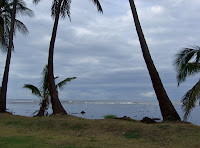Today begins our Holiest of Baha'i festivals- the First Day of Ridvan (Rez-Vahn)
Iran Press Watch has taken the opportunity to share an audio recording of Hand of the Cause Tarazu'llah Samandari.
I was blessed to meet Mr. Samandari twice - In 1967 when I first became a Baha'i. Once in Arizona and once in California. He told the story recounted below about the orange.
He was very frail and light as a feather. One could hear him cough and knew he was not well. After all, he was well into his 90s. But when he appeared and began to speak about Baha'u'llah, his voice gathered strength from somewhere and you could feel that power as he spoke!
Imagine. Meeting someone who was actually in the presence of Baha'u'llah. What a glorious day to be alive!
Hand of the Cause Tarazu'llah Samandari with Gloria Faizi, New Era High School, Panchgani, India, 1967.
Tarázu’lláh Samandarí
(1875-1968)
“Ornament of God”
Tarázu’lláh Samandarí came from an illustrious family. His grandfather was a well-known and highly respected merchant who recognized the Cause of God from the earliest times and his father was an Apostle of Bahá’u’lláh. His grandmother was one of the companions of Táhirih. Bahá’u’lláh gave him his name when he was an infant, and “Tarázu’lláh” means “ornament of God” and his life proved this to be very illustrative.
An accomplished calligrapher, Mullá ‘Alí, known as Jináb-i-Mu’allim, who had been introduced to the Faith by his father and had been praised by Bahá’u’lláh as the first teacher to put into practice Bahá’í principles of education, became his teacher. Tarázu’llah was a good student and later became an outstanding master of calligraphy, revered as a highly educated man, due in part to his exposure to the many wonderful Tablets he copied. His craft enabled him to become familiar, to a unique degree, with the penmanship of the Báb, Bahá’u’lláh and ‘Abdul-Bahá and their various amanuenses, so that in later years he was asked to use this skill to identify many Tablets.
When he was 16 he went on pilgrimage from Iran to the Holy Land, arriving there in November 1891, was there for seven months, and was there when Bahá’u’lláh passed away in May 1892. He has shared many stories over the years. He found that he, like so many believers, was unable to describe His face, for he couldn’t bear to look at it in His presence.
A story shared by Leslie Taherzadeh, widow of author Adib Taherzadeh, recalls one event several weeks in early spring, well before the passing of Bahá’u’lláh. He said that Bahá’u’lláh’s tent had been placed in the garden and when it was time for Bahá’u’lláh to speak, he had been unable to find space in the tent, yet noticed that there was a section with a small table that had been set aside to provide for service to the people in the tent. This section had an open side of the tent directly in front of it, so that one could be “in the tent” but couldn’t see inside, or be seen by those in the tent. So the young Samandarí stood there, essentially right behind Bahá’u’lláh, and could hear every word. So he remained there throughout the time Bahá’u’lláh was talking to the believers. When it was over and people were leaving, they were each handed oranges from baskets by people at the sides of the tent, but there weren’t enough for everyone. The young pilgrim was disappointed that he couldn’t get an orange. At that moment Bahá’u’lláh walked around to the other side of the tent and gave him His orange. Mr. Samandari was so excited that he received an orange directly from His hand! There were quite a few other youth there, and they apparently saw what happened and began to approach him, perhaps with the intention of getting the very special orange. Mr. Samandari remembers running very fast back to the house, eating the orange as he ran, for he didn’t want to share that special orange with anyone!
(28) Excerpted from Barron Harper,
Lights of Fortitude, pp. 307-316.
































 World currencies backed by gold made sense. However, today’s valueless money, issued irresponsibly, pushes world economic order to the brink.
World currencies backed by gold made sense. However, today’s valueless money, issued irresponsibly, pushes world economic order to the brink.

















